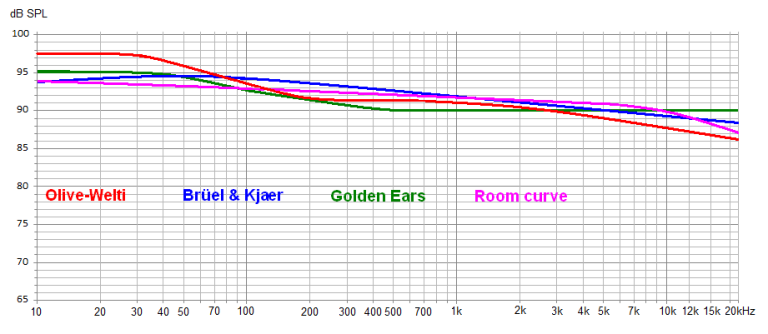Those correction curves (free field and diffuse field) are obtained with 2 different methods. The free field is done in an an-echoic room (as if in non reverberant outside conditions). That correction file is there to compensate for the HRTF of the HATS itself so that when a 'flat' response is coming at the HATS right from the front the plot that comes out of the system also is a flat line.
Very similar as to what comes out from a 'flat' microphone pointed at the same source at the same distance.
That's what the free field is there for... sounds coming from the front.
With headphones sound is coming from the side, totally different result so not usable.
The diffuse field correction is a correction done in a similar way but not with sounds coming from the front but from all around. So from the front, sides, rear... all around. This is yet another curve.
With headphones the sounds are only coming from the side so will also give the wrong results. But at least it is 'better' than freefield.
So both correction files (the opposite of the what the pinna and ear canal 'change' relative to an omnidirectional microphone) are not really suited when the goal is to get correlation between headphone and perceived sound.
But... it is a standard and standardised test rigs should (when presented with free and diffuse field signals) give similar end results.
There will be differences in what the mic capsule inside picks up though. Therefore each HATS will have its own correction files and you cannot really compare 'raw' plots (what the mic inside actually measured) because the used pinnae and ear canals are not the same.
The challenge for HATS users is to create (I assume HATS manufacturers by now will provide a correction file for this use case) an 'average' correction for headphones.
That file too will differ from HATS to HATS (for simplicity as one can fit it with various couplers and pinnae).
The problem is there is no 'reference' headphone like there are reference speakers. Large, small drivers, angled or not, pads etc. differ from headphone to headphone so that's the biggest issue.
So far the correction. Which is the crux here and starting point for another correction.
That would be the room correction. The reason for adding that to the correction is because speakers in a room that radiate a 'flat' response from their position(s) in the room will be changed due to room modes, reflections and distance (small effect) to the listener.
That 'change' in general will be a downward slope from higher frequencies and some 'boost' of lower frequencies.
Below a plot that shows (not exactly but ballpark) what 4 different 'room correction' plots look like
There are several standards that have been determined over the years. The Harman one (Olive-Welti) is based on preferences of listeners and changed a bit over the years as it is newer than the other ones.
That can easily be added to the 'corrected' signal of the microphone so that the resultant plot will be perceived as 'flat' (or should I say realistic) with the room correction.
That curve coming out of this system (coupler/HATS) = correction (diffuse field or specific for 'average' headphones) + 'room correction' based on the choice of the guy doing the measurements will result in a 'flat line plot' and is a target one can EQ on when played at reference level loudness.
Since Harman research has shown that people prefer the boosted bass (the reasons is another debate) an 'average' is established and when we take this more serious than other 'room corrections' then it makes sense for measurement folks/EQ tinkerers to take that as the most 'fitting' target.

